
What is an ASN and How It Helps in Cybersecurity: A Practical Guide
In today’s interconnected world, understanding how data travels across the internet is key to both performance and security. One of the building blocks that make this possible is the Autonomous System Number (ASN). In this guide, you’ll learn about the role of the internet assigned numbers authority :
- What an ASN is and why it matters for Internet routing.
- How ASNs tie into Cybersecurity and the ever‑important BGP protocol.
- Practical tips for using ASN knowledge to boost your network’s safety.
Whether you’re a network operator, IT professional, or simply curious about how the internet works, this article will give you clear, easy‑to‑follow information about understanding ASNs. Let’s get started!
Introduction to Autonomous Systems?
ASN stands for an Autonomous System Number. It is a special number, a special number assigned to large networks that are connected to the internet such as internet providers, big companies or cloud services.
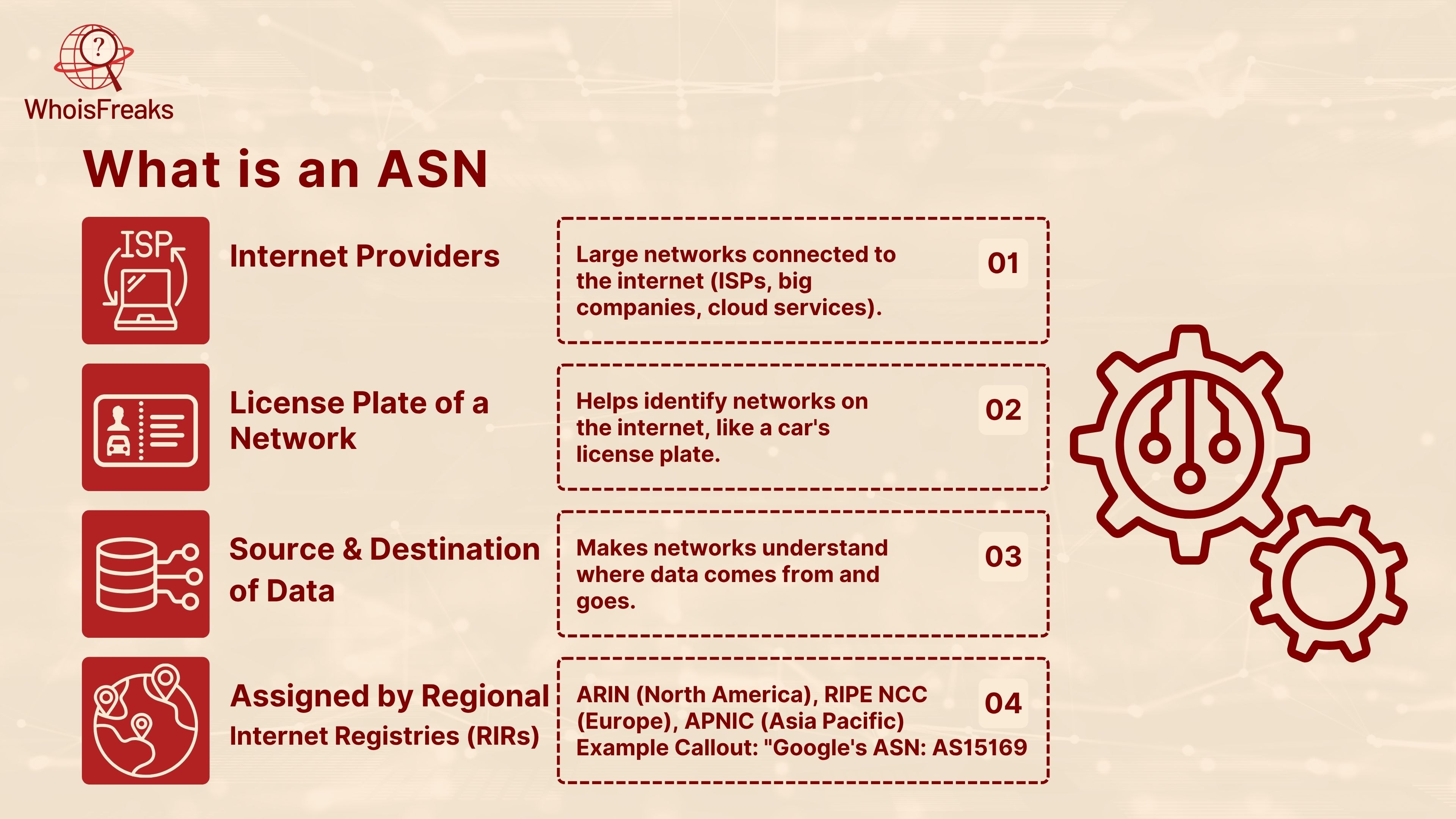
An autonomous system ASN is a bit like a license plate of a network. In the same trend, cars have license plates that help to identify vehicles on the road, networks have ASNs to lead to the identification of networks on the internet.
An ASN makes such networks understand the source and destination of data. It is particularly efficient in routing on the internet such as identifying the destination ip address, that is how internet traffic is carried across various locations. This network is coordinated by an entity known as BGP, which is simply abbreviated to Border Gateway Protocol and which is a sort of map of internet traffic.
ASNs are assigned by official groups known as Regional Internet Registries (RIRs), such as:
- ARIN (for North America)
- RIPE NCC (for Europe)
- APNIC (for Asia Pacific)
Example:
Google has its own ASN -> ASN 15169, which helps manage its massive network traffic around the world.
Why Do We Need ASNs?
The internet is made up of thousands of different networks. These networks need a way to talk to each other safely and correctly. That’s exactly what ASNs help with.
Here’s why we need ASNs:
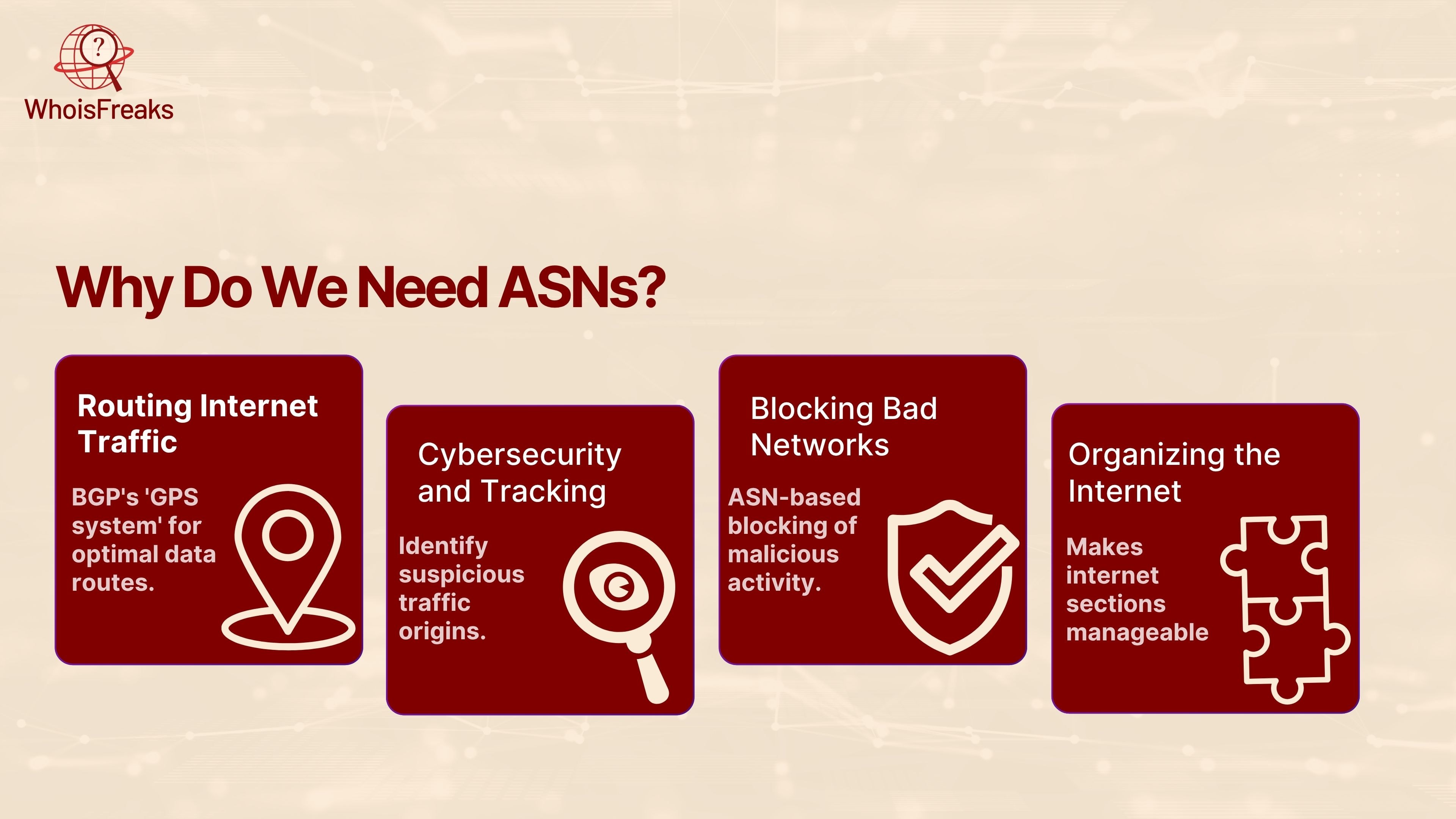
1. Routing Internet Traffic
BGP (Border Gateway Protocol) involves the use of ASNs, which is a form of the GPS system of the internet. It aids in providing data through the optimal route amid networks.
2. Cybersecurity and Tracking
Using ASNs, one can understand where network traffic was launched. It can be of great help in cybersecurity. Having suspicious traffic or dangerous traffic, with the knowledge of the ASN number, we can establish the source of traffic.
3. Blocking Bad Networks
If a certain ASN is known for hosting malicious activity (like phishing domains or attacks) security teams can block it. This is called ASN based blocking.
4. Organizing the Internet
In absence of the ASNs, various kinds of networks within internet would be chaotic and difficult to control. Every ASN creates a section of the internet manageable and simple to administer.
In short, ASN security is about using these unique numbers to keep the internet running smoothly — and more importantly safely.
How ASNs Work (In Easy Words)
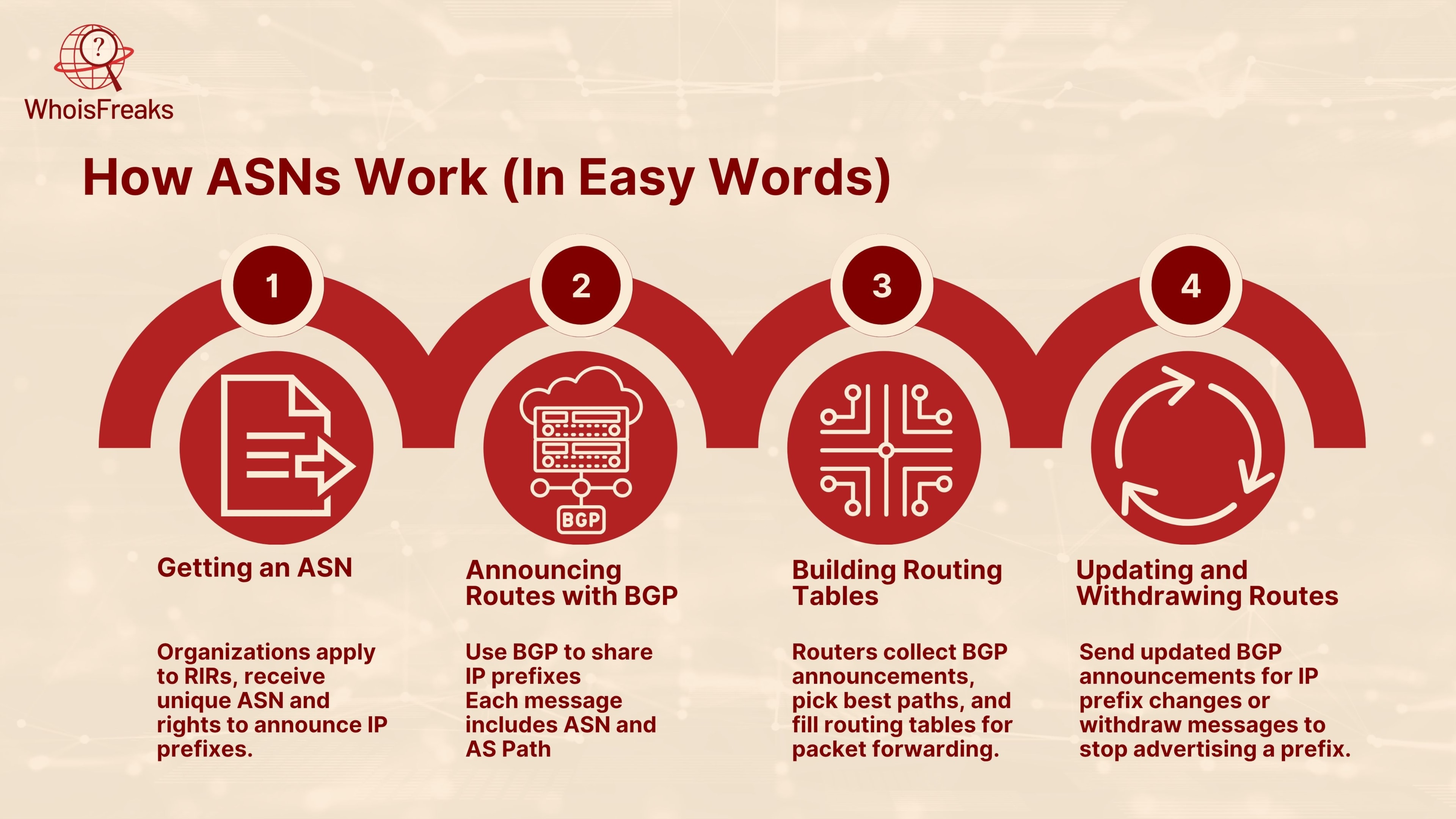
1. Getting an ASN
- Organizations (like ISPs or big companies) apply to a regional internet registry (for example, ARIN in North America or RIPE NCC in Europe).
- Once approved, they receive a unique number their ASN and gain the right to announce their IP prefixes.
2. Announcing Routes with BGP
- To share which IP prefixes your network owns, use the Border Gateway Protocol (BGP).
- You tell your ISP and other partners: “If you want to reach my IP prefix, send traffic through ASN 12345.”
- Routers worldwide receive these announcements and add them to their routing tables.
3. Building Routing Tables
- A router collects BGP announcements from many ASNs.
- It picks the best path to each prefix based on rules like shortest AS path or lowest cost.
- The chosen paths fill its routing table, so when data arrives, the router knows exactly where to forward each packet.
4. Updating and Withdrawing Routes
- If your network’s IP prefixes change for example, you add a new block or retire an old one you send an updated BGP announcement.
- In order to stop advertising a prefix, you withdraw the given message. This instructs others to delete that prefix in their routing tables.
Each BGP message includes your ASN and the path it will take (the AS path). For example:
Prefix: 203.0.113.0/24AS Path: 64500 → 64510 → 12345
ASNs and Cybersecurity: The Connection
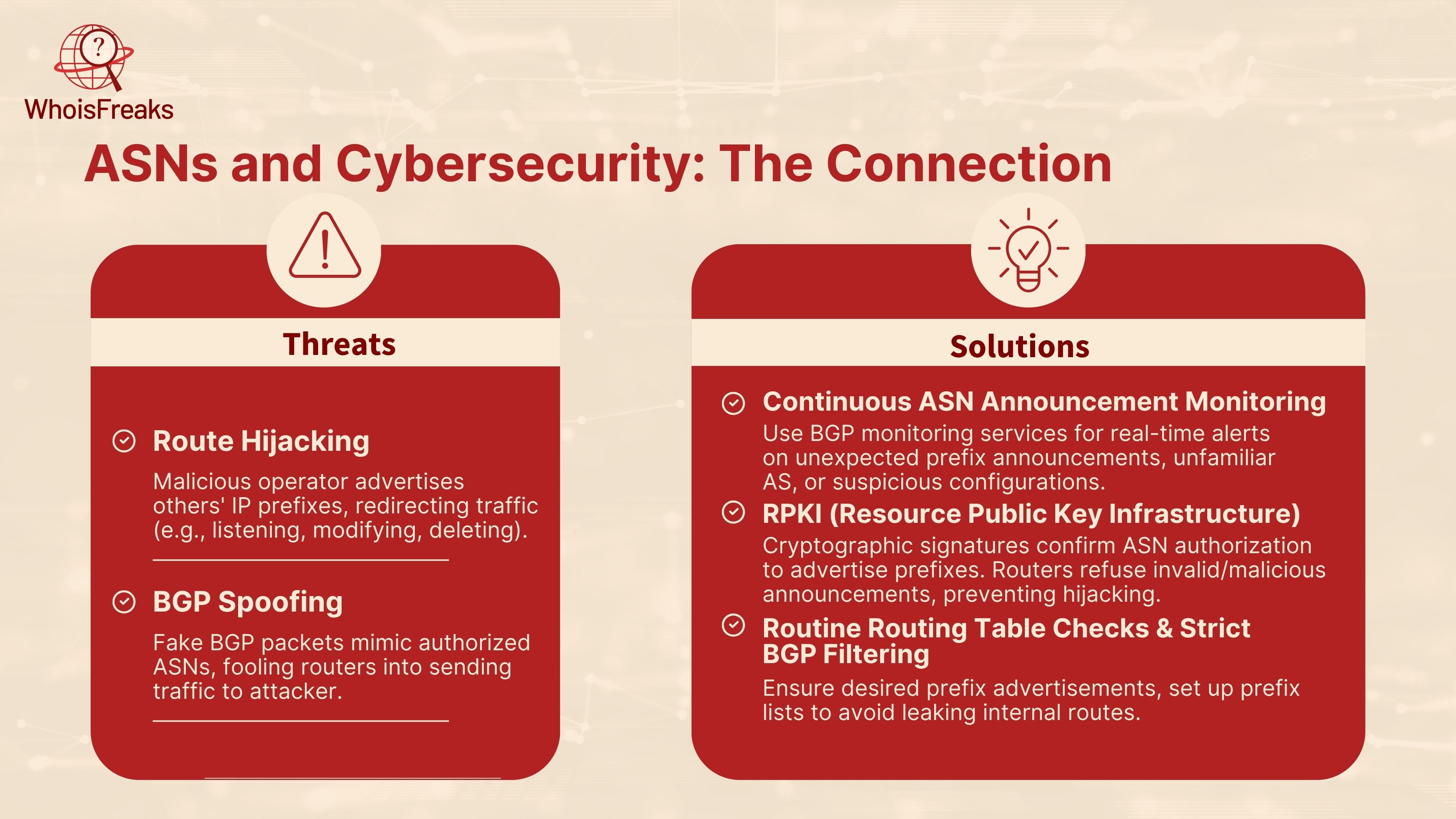
Autonomous System Numbers (ASNs) play a vital role in directing the traffic on the internet, yet they serve the potential of being exploited by hackers, which institute high cyber threats. One of the most severe threats is a route hijacking when an evil network operator advertises the IP prefixes belonging to other people using his own ASN and enjoying malicious behavior . Consequently, the encrypted information that was intended for the legitimate network ends up being redirected to the attacker who then has the opportunity of listening, modifying, or even deleting the traffic. BGP spoofing, where fake Border Gateway Protocol packets are created to mimic an authorized ASN, and by doing so fool routers into sending traffic of interest across the attacker network, is closely related
In order to protect yourself against these threats, your ASNs announcements must be monitored continuously. The use of BGP monitoring services is a common activity by network operators and they notify on real time whenever there is an unexpected prefix announcement or when there is an unfamiliar AS or a suspicious AS configuration on the AS path. Early detection enables you to collaborate with the upstream providers in withdrawing the unauthorized routes before serious damages occur.
One of the strongest methods to fortify the confidence in your routing info is the use of RPKI (Resource Public Key Infrastructure) and the publication of ROAs (Route Origin Authorization). RPKI uses cryptographic key signatures to confirm that ASN is indeed authorized to advertise a given IP prefix. And in case the routers apply RPKI checks, they can automatically refuse to accept invalid or malicious announcements and prevent a large number of hijacking attempts at the network edge.
Lastly, you should have routine checks on your routing tables and ensure that there are harsh BGP filtering policies. Ensure that the prefix advertisements are those desired, and ensure that prefix lists are set up to avoid leaking internal routes. Coupling the diligent observation, cryptography-based authorization, and ultra-code, you can diminish considerably the threat of ASN-based attacks and ensure that the traffic in the network under your control remains safe.
Practical Guide: Using WhoisFreaks ASN Lookup Tool to Strengthen Security
If you need a quick, web‑based ASN lookup no setup required check out the ASN Whois Lookup Tool from WhoisFreaks. Here’s what you get and how to use it for retrieving ASN information:
1. Instant Lookup
- Go to the tool’s page: https://whoisfreaks.com/tools/asn-whois/lookup
- Enter any ASN (for example, AS15169) and click “Lookup.”
- Within seconds, you’ll see key details even without signing in.
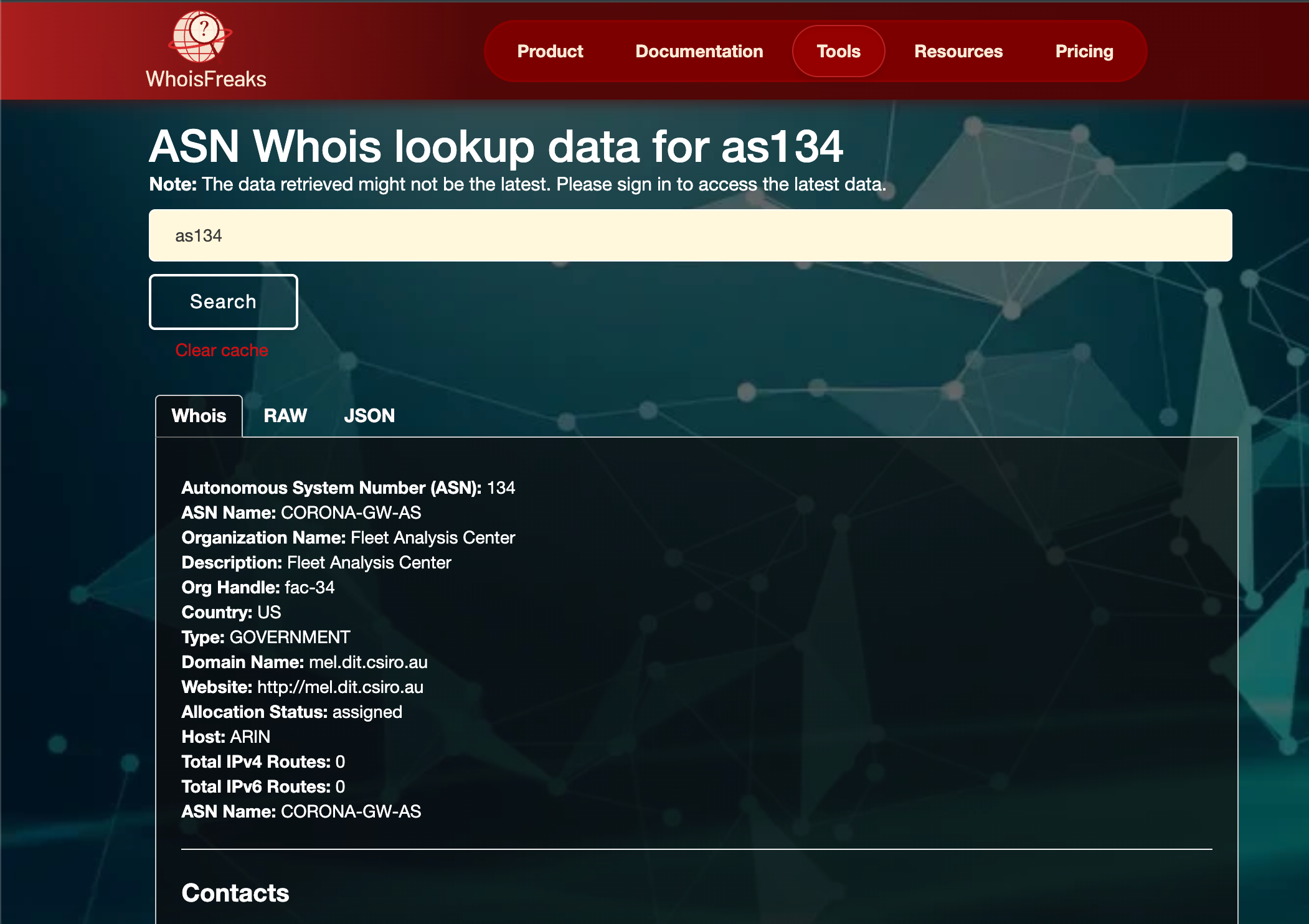
2. What Information It Shows
- ASN Registration: Registry (ARIN, RIPE, etc.), allocation date, country.
- Organization Details: The name, description, and contact emails for administrative and technical teams.
- IP Prefixes: A list of all IP blocks announced by that ASN.
- Routing Status: Current BGP status (active/withdrawn) for each prefix.
- Abuse Contacts: Who to notify if you suspect hijacking or other misuse.
- Powered by an API: Under the hood it uses WhoisFreaks’ real‑time ASN Whois Lookup API so you get fresh data on blocks, contact details, and more.
3. Why It’s Handy
- No account needed for basic info great for fast checks during an incident.
- Covers all regions thanks to its global registry coverage.
- Pairs well with BGP monitoring: when an alert fires, you can immediately look up the offending ASN to learn who’s behind it.
Case Studies
Case Study 1: YouTube Hijack by Pakistan Telecom (February 24, 2008)
Pakistan Telecom (ASN 17557) unintentionally assigned the IP prefix of YouTube (208.65.153.0/24) as their own and all YouTube access throughout the world was then routed through Pakistan Telecom rather than Google network.
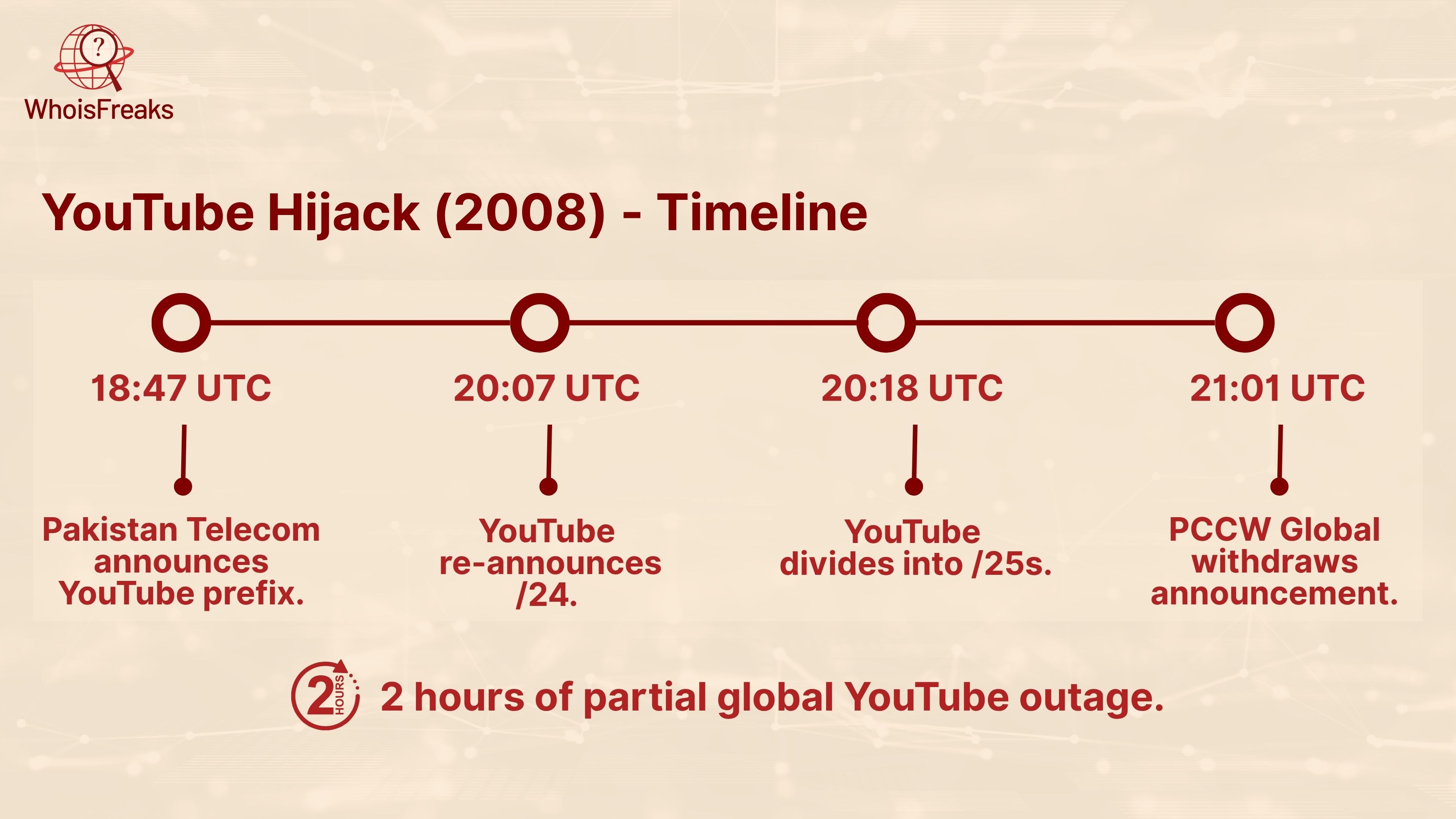
Timeline:
- 18:47 UTC: Pakistan Telecom starts to announce 208.65.153.0/24. The false route is propagated by its upstream provider PCCW Global (ASN 3491) and because of that, router ends up adopting the bogus route for many routers and not the valid route that should be through AS 36561 of YouTube.
- 20:07 UTC: YouTube re-announces /24 prefix to compete with, and, due to longest-prefix and AS-path filtering, some of the traffic continues along the hijacked path.20:18 UTC: YouTube divides the prefix in two /25s (208.65.153.0/25 and 208.65.153.128/25). Longest-prefix match These more specific paths take precedence in all cases (longest-prefix match), rerouting the traffic towards the actual YouTube infrastructure.
- 21:01 UTC: PCCW Global withdraws Pakistan Telecom’s announcement, fully restoring correct routing for YouTube.
Impact & Lessons:
- About 2 hours of partial global YouTube outage.
- Showed how quickly a single mis announcement can propagate across the internet.
- Underlined the need for RPKI/ROA so routers would reject invalid origin ASNs.
Case Study 2: Google Route Leak via Nigerian ISP MainOne (July 12, 2018)
The Nigerian ISP MainOne misconfigured its BGP filters, exposing hundreds of prefixes owned by Google to its upstream providers including China Telecom. The traffic to Google services (Search, G Suite, YouTube) was redirected to the unexpected networks in China and Russia.
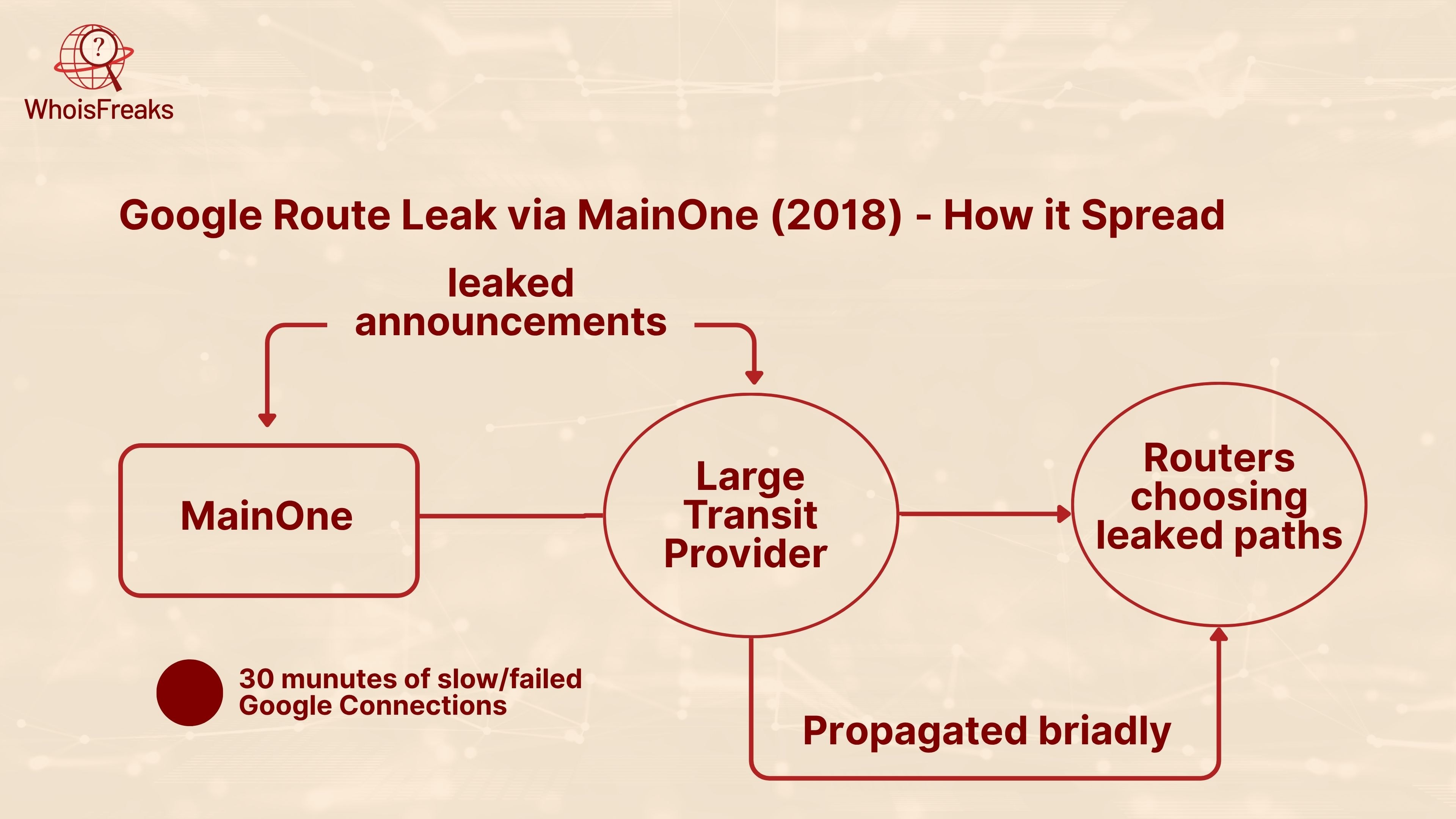
How it spread:
- MainOne’s leaked announcements reached large transit providers, which then propagated them broadly.
- Many routers chose the leaked paths because they appeared “shorter” or simply matched policy despite being unintended.
Duration & Effects:
- For about 30 minutes, Google users saw slow or failed connections as traffic detoured through congested or distant networks.
- Although encrypted, user data briefly traversed regions with extensive surveillance infrastructure.
Key Takeaways:
- Even unintentional “route leaks” can mimic hijacks and disrupt services.
- Highlights the value of monitoring your ASN’s announcements and using RPKI so that invalid routes are filtered out.
Related Tools & Resources
WhoisFreaks also provides multiple free, web based searches to verify ASN(s) and IP ownership information without registering and creating user accounts. The most pertinent to ASN-level investigations are the following ones:
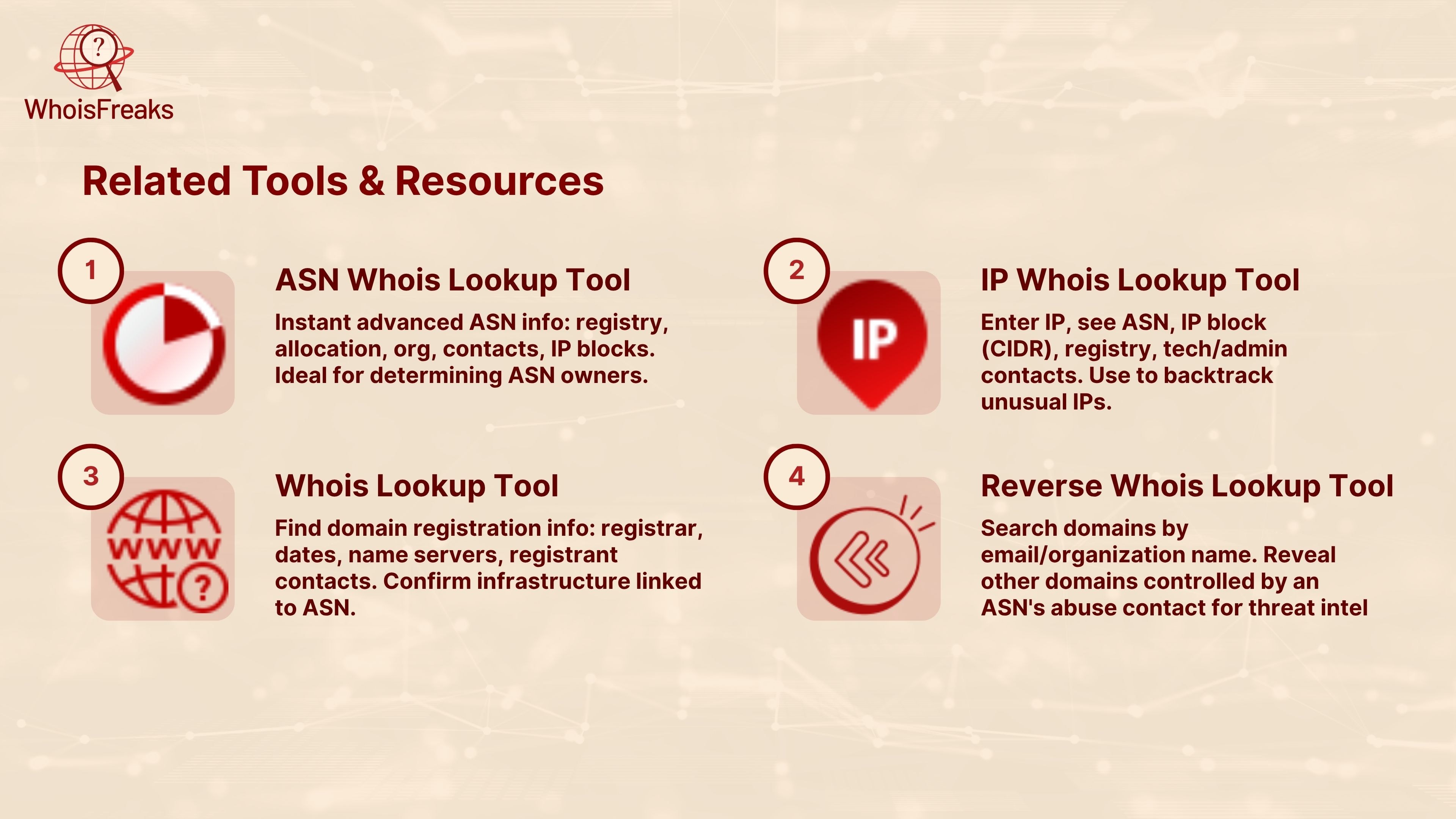
1. ASN Whois Lookup Tool
Retrieves instant advanced ASN information: the registry, the date of allocation, the name of the organization that received it, the emails of contacts, and all announced address blocks. Ideal in determining river owners of an ASN.
2. IP Whois Lookup Tool
Enter any IP address, to see its ASN, IP block (CIDR), information in registry and technical/admin contacts. You use this when you observe an unusual IP in your AS path and you desire to back track it..
3. Whois Lookup Tool
Find out registration information of a domain registrar, creation/expiry dates, name servers, and contact of the registrant. Useful when you have to confirm infrastructure areas connected with an ASN.
4. Reverse Whois Lookup Tool
Search all the domains registered with a name of email or the name of organization. In case of a certain email being used by an abuse contact of an ASN, other domains that the party controls would be revealed that can also be helpful to find threats.
Best Practices for ASN Management
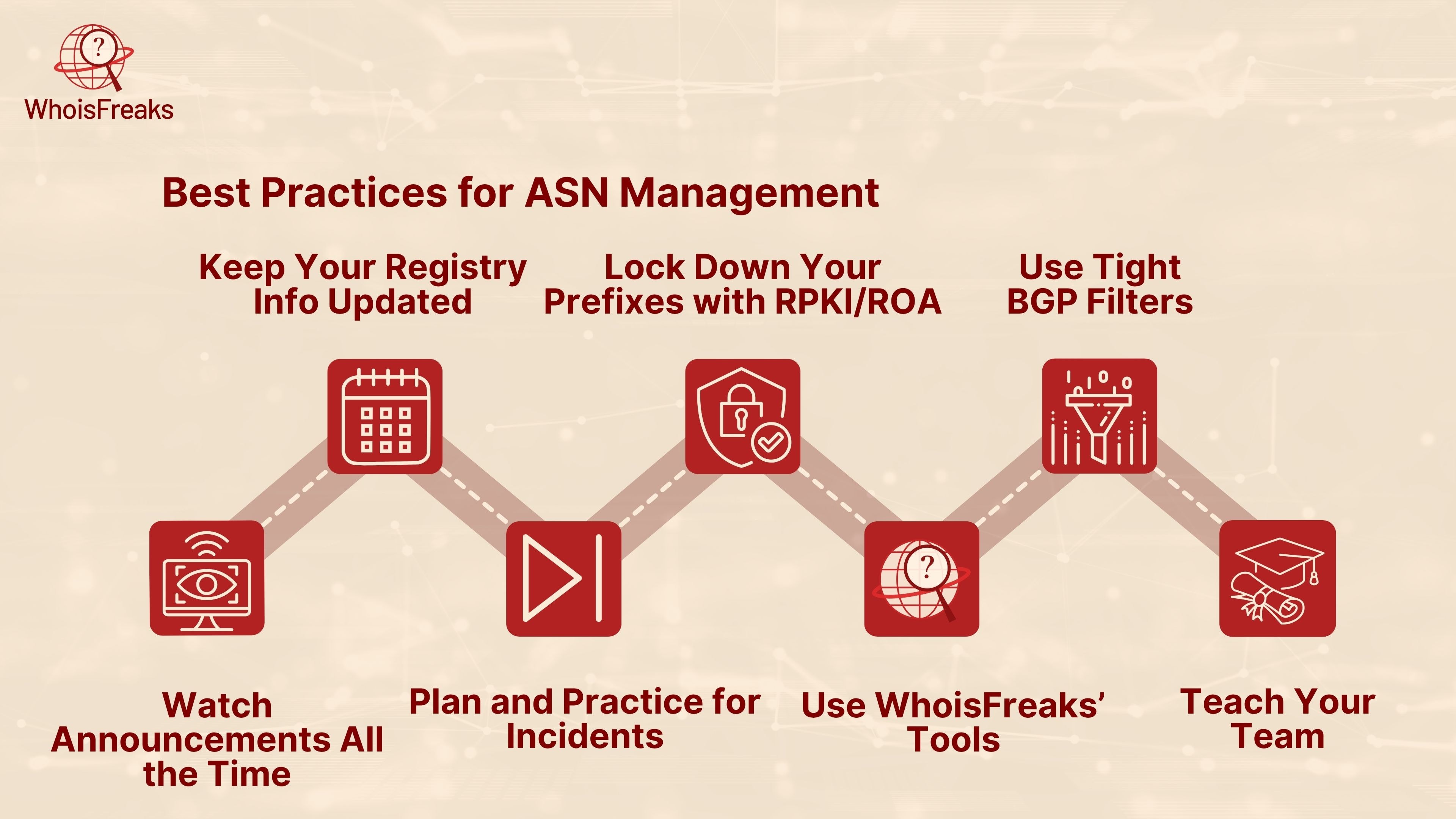
1. Keep Your Registry Info Updated
Ensure that you keep the contact information (email, phone, address) on file by your ASN in your regional registry (ARIN, RIPE, etc.) current at all times. In that manner, you will receive timely notifications such as electrifying and hijacking.
2. Lock Down Your Prefixes with RPKI/ROA
To every block of IP addresses that you have, you ought to form a ROA. One can think of this as a digital signature which means: These addresses only my ASN is allowed to advertise. Request your upstream providers to verify such signatures and any false announcements will be blocked automatically.
3. Use Tight BGP Filters
On your routers, only allow your exact IP ranges to be advertised. Block any private or unassigned addresses. Also, check that incoming BGP announcements from neighbors match the AS paths and prefixes you expect reject anything that doesn’t fit.
4. Watch Your Announcements All the Time
Implement real time notices where you are notified instantly of someone else advertising your prefixes or in case a route goes completely missing. After that, every month, you should put some more attention to analyze your routing table and RPKI status to prevent minor problems that can evolve into major ones.
5. Plan and Practice for Incidents
Write names of whom to call in the upstream providers and registry in case of possible hijack. Do a mock BGP incident exercise every six to twelve months so when pressured your team understands exactly what they should be doing.
6. Use WhoisFreaks' Tools
Keep WhoisFreaks’ ASN Whois Lookup bookmarked. In an emergency, you can quickly find out who owns a suspicious ASN and get the right contact info to report problems.
7. Teach Your Team
Make sure everyone who works on your network understands the basics of BGP, how to set up RPKI, and how to read routing tables. Share real‑world hijack stories so they see why these practices matter.
Conclusion
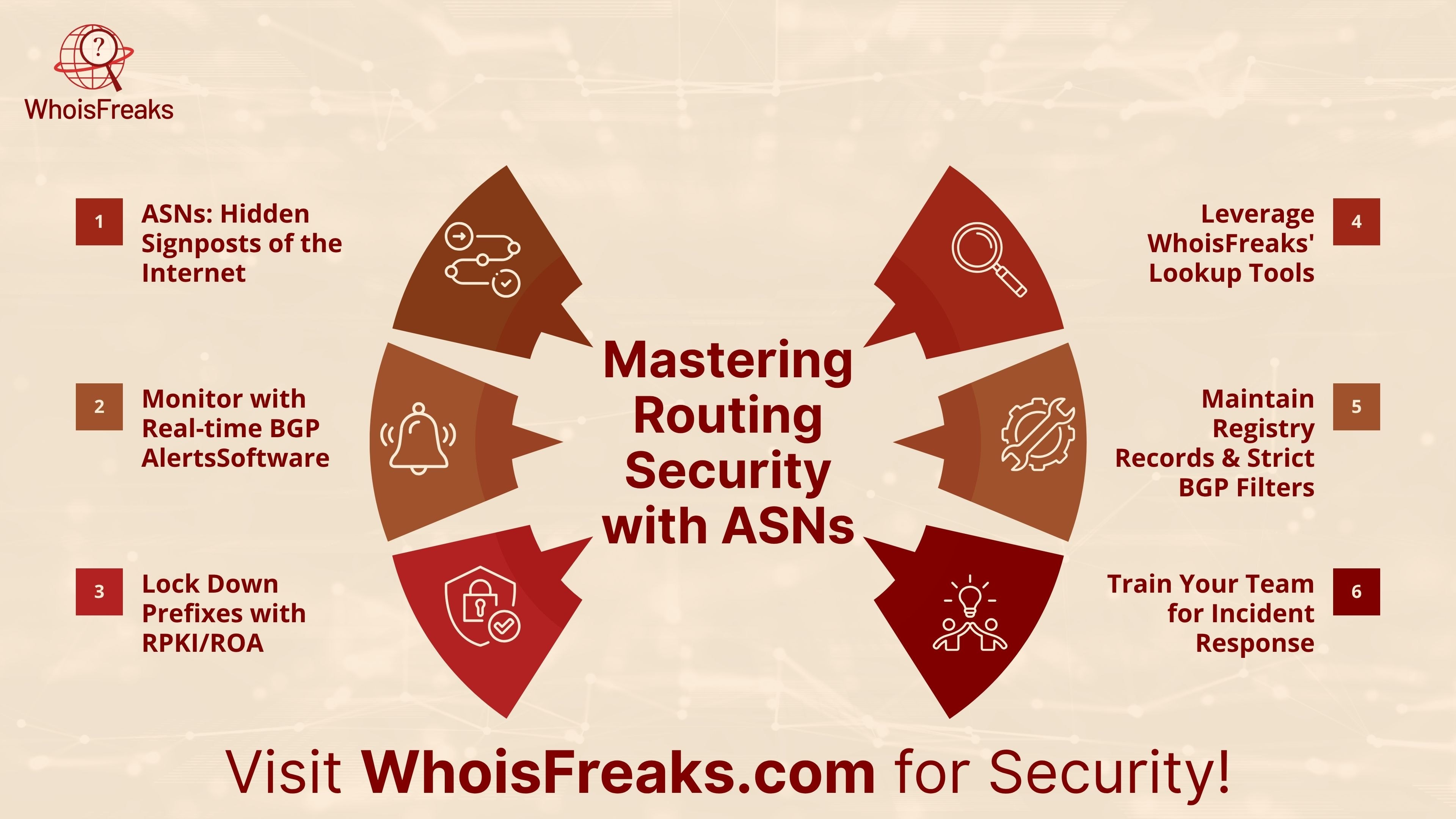
ASNs act like hidden signposts that guide your data across the internet. By watching your ASN with real‑time BGP alerts, using RPKI and ROA to cryptographically lock down prefix announcements, and leveraging WhoisFreaks’ ASN and IP lookup tools for ip intelligence , you can detect and stop route hijacks or spoofing before they impact your network. Keep your registry records up to date, apply strict BGP filters, and train your team on incident response to stay ahead of threats.
Ready to take control of your routing security? Visit WhoisFreaks.com now, look up your ASN, and set up simple BGP alerts today your network (and the wider internet) will thank you.
FAQs
1. What is ASN in cybersecurity?
An ASN (Autonomous System Number), the unique identifier assigned to a network on the internet, helps security teams track where traffic comes from and goes.
2. What is the purpose of ASN?
The main purpose of an ASN is to identify a specific network so routers know how to send data to and from that network.
3. What is the function of ASN?
ASNs tell routers which paths to use by defining a network’s routing policy, ensuring data takes the correct route across the internet.
4. Why do you need an ASN?
You need an ASN so your network can be recognized on a global scale, share routing information, and help detect or block malicious traffic.

Product Lead
A product lead with deep expertise in cybersecurity, adept at analyzing cyber threat data to enhance product resilience against emerging security threats.